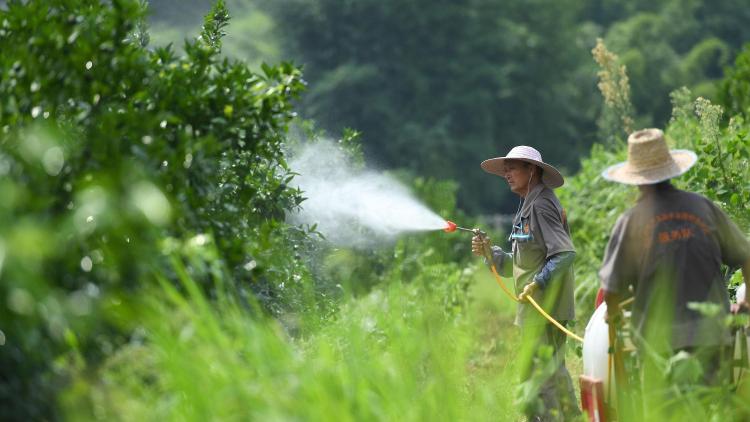
Editor's note: Li Yong is deputy chair of the Expert Committee of the China Association of International Trade. The article reflects the author's opinion, and not necessarily the views of CGTN.
As expected, the first policy document from China's central government in 2021 is again the "No. 1 central document." This document, titled "Opinions of the Central Committee of the Communist Party of China and the State Council on Comprehensively Promoting Rural Revitalization and Accelerating Agricultural and Rural Modernization," was released on February 21.
It is a master plan to address issues relating to agriculture, rural areas and farmers, also known as the "Three Rural Issues".
The "No. 1 central document", as a policy guide for each year, has played a pivotal role in the achievements made so far in China's agricultural and rural developments. Each of the document rolls over the previous one and identifies new challenges to deal with, weaknesses to improve on, bottom lines to maintain, priorities to focus on, specific tasks to perform and key goals to fulfill.
As a result, China has been able to maintain stable grain output of 1.3 trillion jin (1 jin=0.5 kilogram) per year during the 13th Five-Year Plan (2016-2020) period, and farmers' income has more than doubled since 2010 and all of the poverty-stricken rural population has been lifted out of poverty.
Unlike the previous ones, however, this year's "No. 1 central document" reveals the central government's ambitions of a new era and goals to be achieved not just in the current year of 2021, but also in the time span of the 14th Five-Year Plan (2021-2025). The policy statement provides a new vision, as well as a new positioning of agriculture in relation to the country's effort to achieve its second centennial goal.
Rural revitalization key to rejuvenation
As the title of the document reveals, China will put emphasis of its work on the advancement of rural revitalization and acceleration of agricultural and rural modernization. In achieving the goals of constructing a modern socialist country and realizing the great rejuvenation of the Chinese nation, China sees rural areas as the most challenging, and the toughest and most onerous efforts are still required. At the same time, rural areas are also where the most extensive and deepest foundation of development is rooted.
The "Three Rural Issues" have three critical roles to play under the new circumstances. The first is to properly resolve the issues of China's imbalanced and insufficient development. These issues are the key and stumbling blocks as well. This will require efforts to strengthen the weak links in agricultural sectors and rural areas while promoting the coordinated development of both rural and urban development.

Huizhou Village, Shuikou Township, Changxing County, Huzhou City, east China's Zhejiang Province, August 7, 2019. /CFP
Huizhou Village, Shuikou Township, Changxing County, Huzhou City, east China's Zhejiang Province, August 7, 2019. /CFP
Second is to configure a new development pattern. Appropriate solutions to the "Three Rural Issues" will provide potential and momentum, and it is imperative to find ways to boost rural demand by facilitating the economic circulations between rural and urban areas. Lastly, to weather the risks and challenges from home and abroad, the healthy development of agricultural sectors, rural areas and rural population will be the fundamental pillar, and that will necessitate stabilization of the country's agricultural base and safeguard the foundations of agricultural and rural development.
Comprehensive measures shaping the new era of agricultural development
The "No. 1 central document" also embodies a slew of comprehensive measures and guidance designed to achieve quantitative and qualitative objectives and targets in agricultural and rural domains. The logic of the policy document start from general requirements including guiding principles and overall objectives, which set the direction of China's agricultural and rural development.
Then the document moves to the measures intended to consolidate and expand the achieved results of poverty alleviation, so that areas that have just been lifted out of poverty will not go back and their developments are effectively linked to the country's overall objectives of rural revitalization.
Seven tasks have been identified for agricultural modernization, such as achieving breakthroughs in the seed industry and upholding the "red line" of 1.8 billion mu (120 million hectares) of arable land.
The document also lists a series of actions to be taken to vigorously promote rural construction, including rural infrastructure (such as road systems, rural power grids, clean energy, optical fiber networks, 5G mobile communications and mobile Internet of Things), public services, rural demand, integration of rural and urban developments, budgetary support for priority projects and agricultural reforms.
Last but not the least, the document emphasizes the overall leadership by the CPC in all areas of agricultural and rural development. The five-tier working mechanism will be strengthened with CPC secretaries at each level being held responsible for the coordination of resources, grass-root party organization, rural governance and implementation of the rural revitalization.
(If you want to contribute and have specific expertise, please contact us at opinions@cgtn.com.)

